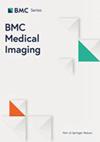Preoperative prediction of histopathological grading in patients with chondrosarcoma using MRI-based radiomics with semantic features
IF 2.9
3区 医学
Q2 RADIOLOGY, NUCLEAR MEDICINE & MEDICAL IMAGING
引用次数: 0
Abstract
Distinguishing high-grade from low-grade chondrosarcoma is extremely vital not only for guiding the development of personalized surgical treatment but also for predicting the prognosis of patients. We aimed to establish and validate a magnetic resonance imaging (MRI)-based nomogram for predicting preoperative grading in patients with chondrosarcoma. Approximately 114 patients (60 and 54 cases with high-grade and low-grade chondrosarcoma, respectively) were recruited for this retrospective study. All patients were treated via surgery and histopathologically proven, and they were randomly divided into training (n = 80) and validation (n = 34) sets at a ratio of 7:3. Next, radiomics features were extracted from two sequences using the least absolute shrinkage and selection operator (LASSO) algorithms. The rad-scores were calculated and then subjected to logistic regression to develop a radiomics model. A nomogram combining independent predictive semantic features with radiomic by using multivariate logistic regression was established. The performance of each model was assessed by the receiver operating characteristic (ROC) curve analysis and the area under the curve, while clinical efficacy was evaluated via decision curve analysis (DCA). Ultimately, six optimal radiomics signatures were extracted from T1-weighted imaging (T1WI) and T2-weighted imaging with fat suppression (T2WI-FS) sequences to develop the radiomics model. Tumour cartilage abundance, which emerged as an independent predictor, was significantly related to chondrosarcoma grading (p < 0.05). The AUC values of the radiomics model were 0.85 (95% CI, 0.76 to 0.95) in the training sets, and the corresponding AUC values in the validation sets were 0.82 (95% CI, 0.65 to 0.98), which were far superior to the clinical model AUC values of 0.68 (95% CI, 0.58 to 0.79) in the training sets and 0.72 (95% CI, 0.57 to 0.87) in the validation sets. The nomogram demonstrated good performance in the preoperative distinction of chondrosarcoma. The DCA analysis revealed that the nomogram model had a markedly higher clinical usefulness in predicting chondrosarcoma grading preoperatively than either the rad-score or clinical model alone. The nomogram based on MRI radiomics combined with optimal independent factors had better performance for the preoperative differentiation between low-grade and high-grade chondrosarcoma and has potential as a noninvasive preoperative tool for personalizing clinical plans.利用基于核磁共振成像的放射组学语义特征对软骨肉瘤患者的组织病理学分级进行术前预测
区分高级别软骨肉瘤和低级别软骨肉瘤极为重要,这不仅能指导个性化手术治疗的发展,还能预测患者的预后。我们旨在建立并验证一种基于磁共振成像(MRI)的提名图,用于预测软骨肉瘤患者的术前分级。这项回顾性研究招募了约114名患者(高分级和低分级软骨肉瘤患者分别为60例和54例)。所有患者均通过手术治疗并经组织病理学证实,按7:3的比例随机分为训练集(80例)和验证集(34例)。然后,使用最小绝对收缩和选择算子(LASSO)算法从两个序列中提取放射组学特征。计算出辐射分数后进行逻辑回归,以建立辐射组学模型。利用多变量逻辑回归建立了将独立预测语义特征与放射组学相结合的提名图。每个模型的性能通过接收者操作特征曲线(ROC)分析和曲线下面积进行评估,临床疗效则通过决策曲线分析(DCA)进行评估。最终,从 T1 加权成像(T1WI)和带脂肪抑制的 T2 加权成像(T2WI-FS)序列中提取了六个最佳放射组学特征,以建立放射组学模型。肿瘤软骨丰度是一个独立的预测因子,与软骨肉瘤分级显著相关(p < 0.05)。放射组学模型在训练集中的AUC值为0.85(95% CI,0.76至0.95),在验证集中的相应AUC值为0.82(95% CI,0.65至0.98),远高于临床模型在训练集中的AUC值0.68(95% CI,0.58至0.79)和在验证集中的AUC值0.72(95% CI,0.57至0.87)。提名图在软骨肉瘤的术前鉴别方面表现良好。DCA分析显示,提名图模型在术前预测软骨肉瘤分级方面的临床实用性明显高于单独的放射评分或临床模型。基于核磁共振成像放射组学的提名图结合最佳独立因素,在术前区分低分级和高级别软骨肉瘤方面有更好的表现,有望成为个性化临床计划的无创术前工具。
本文章由计算机程序翻译,如有差异,请以英文原文为准。
求助全文
约1分钟内获得全文
求助全文
来源期刊

BMC Medical Imaging
RADIOLOGY, NUCLEAR MEDICINE & MEDICAL IMAGING-
CiteScore
4.60
自引率
3.70%
发文量
198
审稿时长
27 weeks
期刊介绍:
BMC Medical Imaging is an open access journal publishing original peer-reviewed research articles in the development, evaluation, and use of imaging techniques and image processing tools to diagnose and manage disease.
文献相关原料
| 公司名称 | 产品信息 | 采购帮参考价格 |
|---|
 求助内容:
求助内容: 应助结果提醒方式:
应助结果提醒方式:


